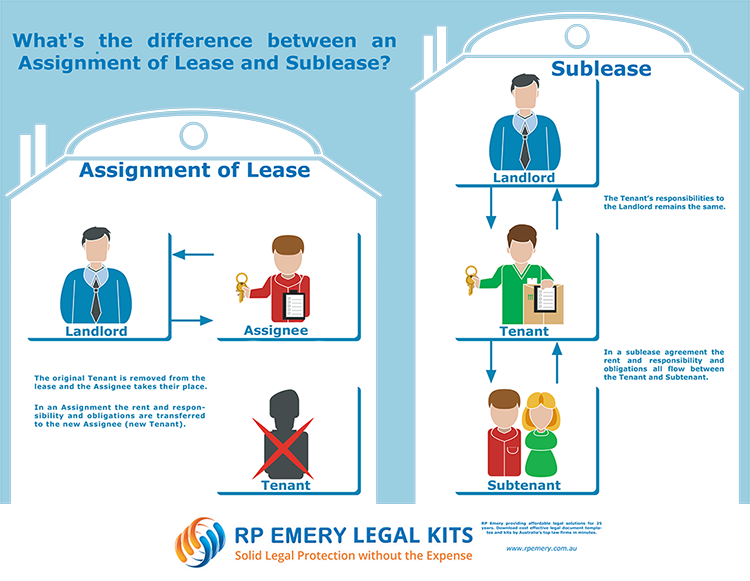“Assigning” and “subletting” may sound like interchangeable terms. But as we shall see, they are vastly different.
If you have space in your leased commercial premises (either all or part) that you are thinking of assigning or subletting to another, you should make yourself familiar with the legal effects, the pros and the cons of both assigning and subletting.
Click to see Larger Version of the diagram
What is an assignment of lease?
Where a tenant decides they no longer wish to be bound by a lease, they can transfer all of their rights and obligations under the Lease to another, who then assumes the position of tenant.
Circumstances where an assignment may be used are:-
- If the tenant needs to relocate to larger premises and no longer wish to be bound to the Lease. Assigning allows the tenant to avoid costs that would otherwise be payable for ending a Lease early;
- If the tenant sells its business, so that the Lease is transferred into the name of the purchaser of the business;
- If the tenant intends to close up shop, assigning the Lease to a new prospective tenant will allow the old tenant to avoid any break lease fees associated with terminating a Lease early.
In any case, an assignment cannot usually occur without the consent of the landlord.
The landlord will want to ensure that the prospective new tenant will be suitably qualified to meet the obligations under the commercial Lease, including financial obligations of rent and outgoings.
The main difference between assigning and subletting a Lease is that, on formalising the assignment with the necessary documentation (usually an Assignment of Lease), the existing tenant will be released of all of their rights and obligations under the Lease, from the date the lease is assigned. From that date, the new tenant takes on all rights and responsibilities under the Lease.
What is a sublease?
A Sublease enables a tenant who has spare space (either the whole or part of a premises) that is not being utilised to sublet that space to another.
Under a sublease, the existing tenant will continue to be named on the Lease, be bound to the Lease terms and liable to the landlord.
The Sublease is essentially an Agreement between the sublessee and the existing tenant. The existing tenant will still ultimately be responsible to the landlord, even for defaults of the sublessee, for example, non-payment of rent or damage to the premises.
The existing tenant will however, have rights of action against the sublessee personally, and may take action to recover any damages against the sublessee.
Should I sublease or assign?
Both subletting and assigning have advantages and disadvantages which must be weighed up in view of your own circumstances.
In many circumstances, the clean break from a Lease provided by an assignment may be preferential.
In other cases, a business may wish to retain control over the whole of the leased premises, while subletting individual offices or portions of space that are not being used at that time.
In any event, you must first refer to your written Lease Agreement to see whether the Lease gives the right to assign or sublet the tenancy and what procedures must be followed in order to achieve this.
Referring to the written terms of your Lease (what you have agreed with your landlord) may redefine your available options.
Generally, a landlord must not unreasonably refuse an assignment of lease, but may, at it’s absolute discretion refuse a sublease. However, this will ultimately depend on the wording or your own Lease and whether any legislation applies.
Legislation will apply if your Lease is for retail premises (premises involved in the retail sale of goods or services to the public). Retail lease legislation regulates retail leases and how and when a retail lease can be assigned, the procedure and the rights of the tenant and landlord (depending on your State). You should refer to the retail tenancies legislation in your State if this is the case.
For more information and resources:-
Landlords Guide: What to do if your tenant wants to assign or sublease a Commercial property
 There are a variety of circumstances that might lead your tenant to ask for an assignment of the lease or to sublet the leased premises. This article outlines the steps a Landlord of a commercial property should take if your tenant asks this question.
There are a variety of circumstances that might lead your tenant to ask for an assignment of the lease or to sublet the leased premises. This article outlines the steps a Landlord of a commercial property should take if your tenant asks this question.
Commercial Sublease Agreement Template Kit
Difference between a lease and licence
Pros and cons of subleasing a premises




